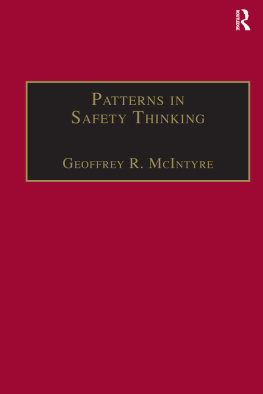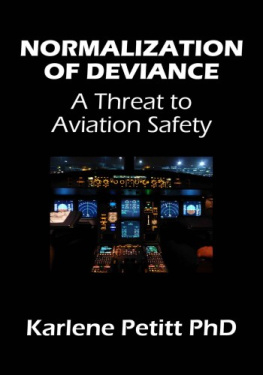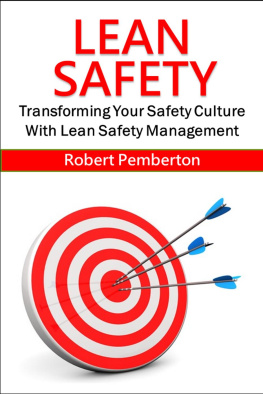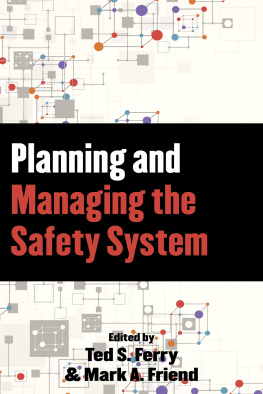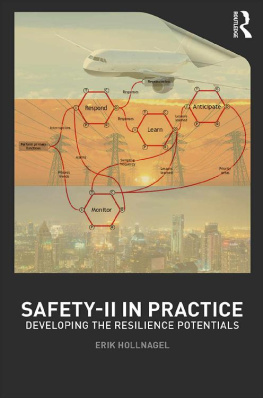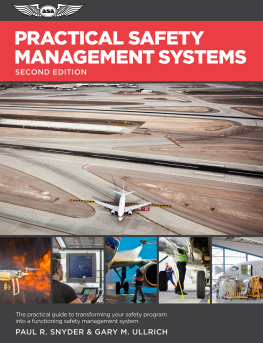First published 2000
by Ashgate Publishing
Published 2016
by Routledge
2 Park Square, Milton Park, Abingdon, Oxon OX14 4RN
711 Third Avenue, New York, NY 10017, USA
Routledge is an imprint of the Taylor & Francis Group, an informa business
Copyright 2000 Geoffrey R. McIntyre
All rights reserved. No part of this book may be reprinted or reproduced or utilised in any form or by any electronic, mechanical, or other means, now known or hereafter invented, including photocopying and recording, or in any information storage or retrieval system, without permission in writing from the publishers.
Notice:
Product or corporate names may be trademarks or registered trademarks, and are used only for identification and explanation without intent to infringe.
British Library Cataloguing in Publication Data
McIntyre, Geoffrey R.
Patterns in safety thinking: a literature guide to air
transportation safety
1.Airlines - United States - Safety measures - Bibliography
2.Airlines - United States - Safety measures - History
Bibliography
I.Title
016.3'63124'0973
Library of Congress Catalog Card Number: 00-132578
ISBN 9780754613220 (hbk)
Transfered to Digital Printing in 2009
A 1992 survey by the American Society of Mechanical Engineers made the startling revelation that almost 80 percent of engineers had never taken a safety course in college nor ever attended a safety conference or a safety lecture. This naturally, has raised questions about the academic preparation of engineers who are charged with building and operating complex, high-risk socio-technical systems safely; as well as questions about the nature of the safety principles that underline their support. Traditionally, "safety" has been treated as part of the overall design process rather than being the focus of a specific discipline of study. At the end of this century and the next one, these questions are at the heart of American civilization's thinking and communicating about "safety."
Patterns In Safety Thinking: A Literature Guide To Air Transportation Safety, was written in response to an expressed need by aviation safety management trainees for a practical and concise educational supplement to the safety literature as it relates to the theory and practice of U.S. transportation safety. This essay will examine and classify the major books and select journals on transportation safety and where appropriate, provide real world, practical illustrations of the theoretical concerns. It is primarily designed to educate aviation transportation safety practitioners on the broad outlines of the history, theory and practice of "safety management" in the United States. Several aviation safety trainees under the time-sensitive pressure of typical training programs have expressed the need for concise reference material that would provide a broad orientation and conceptual overview of safety management. The essay meets that requirement. As a potential educational supplement for undergraduate engineering students, the essay serves as a guide to stimulate interdisciplinary thinking about "safety." It should also be of assistance in meeting public policy objectives to better communicate aviation safety risk to the public. The essay takes readers on an historical journey that explains how the streams of several academic disciplines, as well as the safety actions of individuals, have merged to create the omni-disciplinary nature of "safety."
This essay classifies the transportation safety literature into a theoretical framework of distinct and apparently self-reinforcing "schools" of safety management thought: The "Tort Law School," the "Reliability Engineering School," and the "System Safety Engineering School." In addition to this categorization of the literature, it has provided a context with the inclusion of new and practical, real-world illustrations drawn largely from the aviation sector. The goal of the essay is to educate rather than to train safety engineers, students and practitioners. In general, both students and practitioners are faced with a bewildering array of highly technical, specialized and esoteric literature drawn from several disciplines, including the cognitive and mathematical sciences, probability theory, risk management, engineering, organizational theory, tort law, and the political economy and philosophy of regulation. This omni-disciplinary character has impacted the practice of safety as an integral component of corporate management and governmental regulatory actions.
Patterns In Safety Thinking, was conceived as an educational supplement to safety management training courses for aviation safety practitioners. Generally, aviation safety training courses are very intense, time sensitive, cookbooky and largely concentrate on the application of standard reliability engineering tools and techniques of modern probability theory. Many System Safety theoreticians and practitioners believe that the challenges posed by software-intensive systems will require a broadening of the scope of aviation safety training to include developing an ability to asking the right questions when thinking about safety. In 1978, there emerged from the safety literature new thinking by sociologists, organizational theorists and psychologists that furthered managerial understanding of the System Safety discipline. This work has examined some evolving transportation safety education, risk management and communication challenges of the 21st century.
The century-old theme that safety is everyone's concern began in 1874 with the actions of Lorenzo Coffin, the almost forgotten railroad safety advocate and champion of the Railroad Safety Appliance Act, 1893. Coffin would later serve as the role model for Ralph Nader, the 20th century's most famous safety advocate. The essay, where relevant, will also reference significant technological advances and on-the-job aviation practices of this "practical discipline." It also examines the individual actions of "ordinary" human beings that have impacted, and continue to impact safety. The tragic consequences of accidents and unsafe conditions on our lives suggest that safety is indeed everyone's concern. Thus, at the beginning of the 21st century, "safety," far from being viewed as the sole domain of design engineers and risk managers with their market-based models of economic rationality, has become the entrance upon a quite incalculably wider stage that has coalesced into unique patterns of thinking about "safety." This essay should also be of some assistance in meeting U.S. public policy objectives to further educate consumers about the safety of the air transportation system. It provides a framework for analysis and discussion of the 1990s issue of communicating aviation safety risk to the public. The airspace system daily handles more than 174,000 takeoffs and landings at airports across the nation, and routinely carries approximately 1.7 million passengers safely to their destinations. The White House Commission on Aviation Safety and Security has assigned a top priority to reducing aviation's accident rate.
Like the Roman God, Janus, "safety" may be portrayed as facing two ways: backward to the past and forward to the future. In transportation, after an accident occurs, the National Transportation Safety Board conducts an investigation to determine the cause (s) and what must be done to prevent a recurrence. In the aviation sector, this approach has been known as "Fly-Fix-Fly." Thus, the dreadful trade of accident investigation looks backwards and hopes to eliminate future sources of trouble. In contrast, the "System Safety" approach could be described as "forward looking" to the future with a focus on accident prevention. This involves a before-the-fact process that may be characterized as the identify-analyze-control method of safety to enable us to answer the question: How do we know that a system is safe? A central thesis of this essay is that safety is more than the absence of accidents. Safety is defined as the goal of transforming the levels of risk that inheres in all human activity. Such a view of "safety" challenges the intellectually entrenched tendency to communicate future risk likelihood based solely on studies of past accidents.

